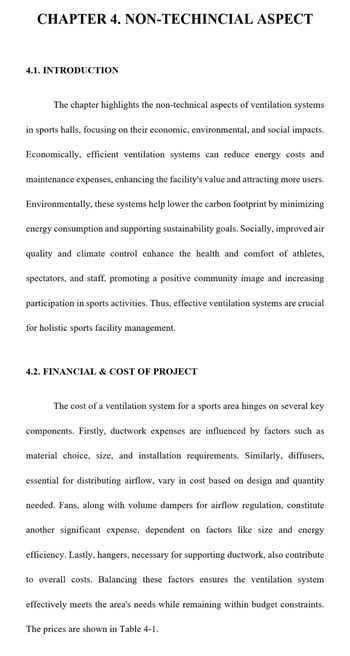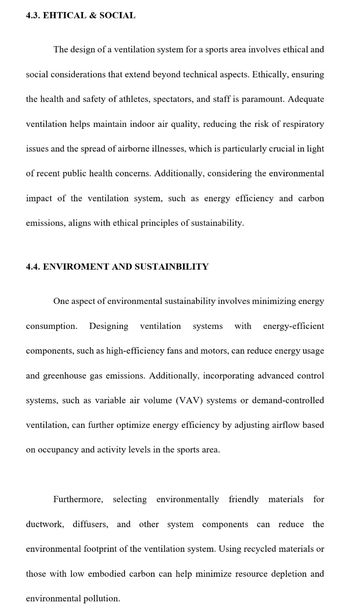
Elements Of Electromagnetics
7th Edition
ISBN: 9780190698614
Author: Sadiku, Matthew N. O.
Publisher: Oxford University Press
expand_more
expand_more
format_list_bulleted
Question
I want to briefly summarize what he is talking about.

Transcribed Image Text:CHAPTER 4. NON-TECHINCIAL ASPECT
4.1. INTRODUCTION
The chapter highlights the non-technical aspects of ventilation systems
in sports halls, focusing on their economic, environmental, and social impacts.
Economically, efficient ventilation systems can reduce energy costs and
maintenance expenses, enhancing the facility's value and attracting more users.
Environmentally, these systems help lower the carbon footprint by minimizing
energy consumption and supporting sustainability goals. Socially, improved air
quality and climate control enhance the health and comfort of athletes,
spectators, and staff, promoting a positive community image and increasing
participation in sports activities. Thus, effective ventilation systems are crucial
for holistic sports facility management.
4.2. FINANCIAL & COST OF PROJECT
The cost of a ventilation system for a sports area hinges on several key
components. Firstly, ductwork expenses are influenced by factors such as
material choice, size, and installation requirements. Similarly, diffusers,
essential for distributing airflow, vary in cost based on design and quantity
needed. Fans, along with volume dampers for airflow regulation, constitute
another significant expense, dependent on factors like size and energy
efficiency. Lastly, hangers, necessary for supporting ductwork, also contribute
to overall costs. Balancing these factors ensures the ventilation system
effectively meets the area's needs while remaining within budget constraints.
The prices are shown in Table 4-1.

Transcribed Image Text:4.3. EHTICAL & SOCIAL
The design of a ventilation system for a sports area involves ethical and
social considerations that extend beyond technical aspects. Ethically, ensuring
the health and safety of athletes, spectators, and staff is paramount. Adequate
ventilation helps maintain indoor air quality, reducing the risk of respiratory
issues and the spread of airborne illnesses, which is particularly crucial in light
of recent public health concerns. Additionally, considering the environmental
impact of the ventilation system, such as energy efficiency and carbon
emissions, aligns with ethical principles of sustainability.
4.4. ENVIROMENT AND SUSTAINBILITY
One aspect of environmental sustainability involves minimizing energy
consumption. Designing ventilation systems with energy-efficient
components, such as high-efficiency fans and motors, can reduce energy usage
and greenhouse gas emissions. Additionally, incorporating advanced control
systems, such as variable air volume (VAV) systems or demand-controlled
ventilation, can further optimize energy efficiency by adjusting airflow based
on occupancy and activity levels in the sports area.
Furthermore, selecting environmentally friendly materials for
ductwork, diffusers, and other system components can reduce the
environmental footprint of the ventilation system. Using recycled materials or
those with low embodied carbon can help minimize resource depletion and
environmental pollution.
Expert Solution
This question has been solved!
Explore an expertly crafted, step-by-step solution for a thorough understanding of key concepts.
Step by stepSolved in 2 steps

Knowledge Booster
Similar questions
- Statics Problem !!! Help me Part A and Part B!!!! Answer it this Problem Correctly!! Please give correct Solutionarrow_forwardI already calculated the viscosity to be 1.91 but I don't know how to derive the propagation error calculation of viscosity. helparrow_forwardWhat is the specific? weight of nitrogen in units of new temper cubeter. at the temperature of minus 10 Celsius and the pressure of 0.6 bar gauge ? Please. I want you to give me details in how you confirm each unit.arrow_forward
- If air is at pressure P of 3200 lb/ft2 and a temperature T of 800R degrees, what is the specific volume? (neat handwritten)arrow_forwardSelect the correct statements regarding moment and torque. (Select 3) Moment and Torque are two different phenomena, hence SI- units are different Generally Moment is used when there is no rotation, while torque is used when there is rotation. Moment and torque are very similar concepts and are sometimes interchangeable Moment and Torque are calculated by force multiplied by its distance to the reference point.arrow_forwardI need help with this Please help mearrow_forward
- - The system shown in the figure is used to accurately measure the pressure changes when the pressure is increased by AP in the water pipe. When (Ah 70 mm), what is the change in the pipe pressure. Glysa 50-13 D-10 do 3mmarrow_forward. What force would be exerted against a seawall if a 1:36 model 0.914 m long experienced a wave force of 120 N?4. A surface vessel 156arrow_forwardWrite what you understand and conclusion in this example, answer simply.arrow_forward
arrow_back_ios
arrow_forward_ios
Recommended textbooks for you
 Elements Of ElectromagneticsMechanical EngineeringISBN:9780190698614Author:Sadiku, Matthew N. O.Publisher:Oxford University Press
Elements Of ElectromagneticsMechanical EngineeringISBN:9780190698614Author:Sadiku, Matthew N. O.Publisher:Oxford University Press Mechanics of Materials (10th Edition)Mechanical EngineeringISBN:9780134319650Author:Russell C. HibbelerPublisher:PEARSON
Mechanics of Materials (10th Edition)Mechanical EngineeringISBN:9780134319650Author:Russell C. HibbelerPublisher:PEARSON Thermodynamics: An Engineering ApproachMechanical EngineeringISBN:9781259822674Author:Yunus A. Cengel Dr., Michael A. BolesPublisher:McGraw-Hill Education
Thermodynamics: An Engineering ApproachMechanical EngineeringISBN:9781259822674Author:Yunus A. Cengel Dr., Michael A. BolesPublisher:McGraw-Hill Education Control Systems EngineeringMechanical EngineeringISBN:9781118170519Author:Norman S. NisePublisher:WILEY
Control Systems EngineeringMechanical EngineeringISBN:9781118170519Author:Norman S. NisePublisher:WILEY Mechanics of Materials (MindTap Course List)Mechanical EngineeringISBN:9781337093347Author:Barry J. Goodno, James M. GerePublisher:Cengage Learning
Mechanics of Materials (MindTap Course List)Mechanical EngineeringISBN:9781337093347Author:Barry J. Goodno, James M. GerePublisher:Cengage Learning Engineering Mechanics: StaticsMechanical EngineeringISBN:9781118807330Author:James L. Meriam, L. G. Kraige, J. N. BoltonPublisher:WILEY
Engineering Mechanics: StaticsMechanical EngineeringISBN:9781118807330Author:James L. Meriam, L. G. Kraige, J. N. BoltonPublisher:WILEY

Elements Of Electromagnetics
Mechanical Engineering
ISBN:9780190698614
Author:Sadiku, Matthew N. O.
Publisher:Oxford University Press

Mechanics of Materials (10th Edition)
Mechanical Engineering
ISBN:9780134319650
Author:Russell C. Hibbeler
Publisher:PEARSON

Thermodynamics: An Engineering Approach
Mechanical Engineering
ISBN:9781259822674
Author:Yunus A. Cengel Dr., Michael A. Boles
Publisher:McGraw-Hill Education

Control Systems Engineering
Mechanical Engineering
ISBN:9781118170519
Author:Norman S. Nise
Publisher:WILEY

Mechanics of Materials (MindTap Course List)
Mechanical Engineering
ISBN:9781337093347
Author:Barry J. Goodno, James M. Gere
Publisher:Cengage Learning

Engineering Mechanics: Statics
Mechanical Engineering
ISBN:9781118807330
Author:James L. Meriam, L. G. Kraige, J. N. Bolton
Publisher:WILEY